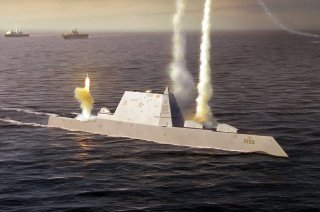Zumwalt-Class Stealth Destroyers: Transform Them Into 'Command Ships'?
The U.S. Navy's two aging Blue Ridge-class amphibious command ships, USS Blue Ridge and USS Mount Whitney, have been critical for fleet coordination since the 1970s. However, these vessels are vulnerable in modern combat environments, prompting calls to repurpose Zumwalt-class destroyers as replacements.
Top 3 Points: The U.S. Navy's two aging Blue Ridge-class amphibious command ships, USS Blue Ridge and USS Mount Whitney, have been critical for fleet coordination since the 1970s. However, these vessels are vulnerable in modern combat environments, prompting calls to repurpose Zumwalt-class destroyers as replacements.

-The Zumwalt's advanced stealth, armament, and cutting-edge systems make it a more suitable platform for fleet command in today’s high-threat maritime landscape.
-Retrofitting these destroyers as command ships could preserve vital command and control capabilities while ensuring survivability against near-peer adversaries.
Make the Zumwalt-class Destroyer a Replacement for the Old Blue-Ridge-class Command Ship
In the 1970s, anticipating a need to conduct and coordinate massive fleet operations, the U.S. Navy built two Blue Ridge-class amphibious command ships. These two units were named USS Blue Ridge (LCC-19) and USS Mount Whitney (LCC-20).
Capable of cruising at 23 knots while carrying a crew of 34 officers and 564 enlisted sailors, both ships have served as a command ships. USS Blue Ridge became the Seventh Fleet command ship in 1979, and USS Mount Whitney served as the Second Fleet command ship. These two boats are among the most unique vessels in the Navy.
Upgrading The Command Ship
Before 1971, Navy amphibious command ships lacked sufficient speed to keep up with a 20-knot amphibious force, according to Military.com. These vessels are so important the fleet operations that both ships went through an Extended Service Life Program (ESLP) conducted jointly by NAVSEA and Military Sealift Command. Military.com assessed that “ESLP [was] focused on ensuring the platforms [could] support the full range of mission requirements for an embarked numbered fleet commander.”
When the two ships were created, the great fear was that the West and their Soviet rivals would enter a full-blown war. That war would not only be relegated to the killing fields of Europe but would spread to every corner of the world, including on the high seas. The Navy wanted to be ready with a capability that could ensure fleets were well coordinated and led.
The design of the Blue Ridge-class amphibious command ships breaks significantly with traditional warship aesthetics. While they can keep up with the fleet, they are not built for speed. Their armaments are relatively weak, too. Although what these ships lack in offensive capabilities, they have an impressive defensive array. Notably these ships possess Phalanx CIWS (Close-In Weapon System) to protect themselves from incoming missiles and air threats.
Everything about these boats is designed to make them the brain of a fleet in combat.
Toward that end, these warships have state-of-the-art command centers that handle the operational demands of a fleet or joint task force. Things like advanced radar, electronic warfare suites, and secure communications systems are all featured on these two ships.
A (Brief) History
Indeed, these boats have served as the flagships for various fleet commanders. Admirals and their aides, as well as significant numbers of staff, all tend to serve on these ships. The goal is to have top fleet leadership underway with their fleets.
Blue Ridge-class amphibious command ships have large flight decks and hangar facilities to host a wide array of helicopters. These choppers conduct reconnaissance missions, and they are used for transporting the various flag officers and their staffs to-and-from the command ships.
Another key feature of the Blue Ridge class is its fuel-carrying capacity. Because these ships are meant to operate in wartime conditions with a near-peer rival, the ships are designed to house large amounts of fuel allowing for extended command presence.
Blue Ridge-class amphibious command ships are key for moving troops from the sea to the shore. They manage logistics for the fleet to ensure its operational tempo is not disrupted, and they provide real-time intelligence. What’s more, the command ships can play pivotal roles both in military operations as well as during disaster relief missions.
A Bit Redundant
Possessing a command ship capability was a vital need during the Cold War. Today, however, the functionality of these ships seems to be murkier, which is likely why the Navy has not built more than two of these boats. Such ships would be easy targets for enemy fleets looking to decapitate a U.S. Navy fleet’s command staff.
To overcome the threat that the modern combat environment poses to the safety of the Blue Ridge-class command ships, Lt. Kyle Cregge in 2020 recommended that Zumwalt-class destroyers be repurposed for fulfilling this role. That might be the best solution, as the old Blue Ridge-class ships are not well-suited to the current threats on the maritime battlefield.
Naval planners should design a way to make an existing warship a command ship that will not be easily taken out.
Author Experience and Expertise: Brandon J. Weichert
Brandon J. Weichert, a National Interest national security analyst, is a former Congressional staffer and geopolitical analyst who is a contributor at The Washington Times, the Asia Times, and The-Pipeline. He is the author of Winning Space: How America Remains a Superpower, Biohacked: China’s Race to Control Life, and The Shadow War: Iran’s Quest for Supremacy. His next book, A Disaster of Our Own Making: How the West Lost Ukraine, is due October 22 from Encounter Books. Weichert can be followed via Twitter @WeTheBrandon.
All images are Creative Commons or Shutterstock.
From the Vault
Russia Freaked Out: Why the U.S. Navy 'Unretired' the Iowa-Class Battleships
Battleship vs. Battlecruiser: Iowa-Class vs. Russia's Kirov-Class (Who Wins?)


